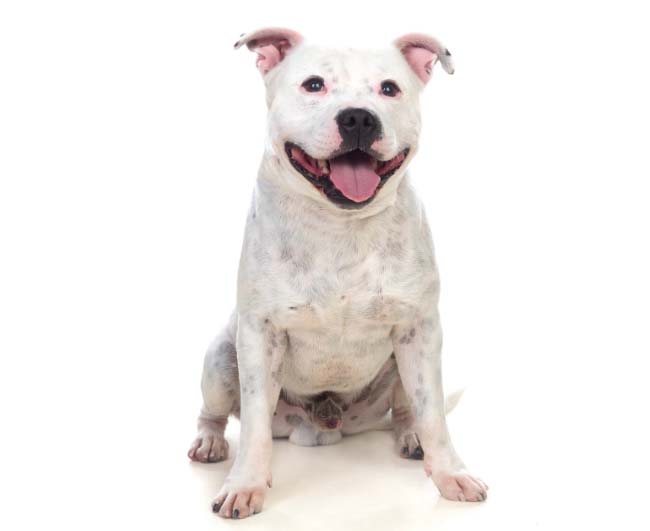We've gone Pink to help fight Breast Cancer.
Use code "BREAST" and we'll Donate $50 to National Breast Cancer Foundation
Main Menu
Petsy Breed Pages
The world’s most comprehensive information on the ...

$1500.00 - $2000.00
Stafford Staffy
Medium
Terrier Group
Short
Medium
Medium
12 to 14 years

Would you like to know what it would cost to insure an Staffordshire Bull Terrier? Find out by getting a free quote, with petsy pet insurance.













Staffordshire Bull Terrier come in a variety of colours, including Black, Blue, Brindle and White, Brindle , Red, White with Blue Markings, Black.


How much do
Staffordshire Bull Terrier eat?
1.00 to 2.00 cups of food a day

How much
exercise do they need?
30 to 60 Mins

Are they kid friendly? This breed of dog is fearless, friendly, tolerant and totally reliable, in particular with children

Do they need a lot of space? Staffordshire Bull Terriers are medium dogs which don't need a lot of space at home to be happy
Patellar Luxation
Legg-Perthes Disease
Hip Dysplasia
Heart murmurs
It is recommended for your Staffy to have 1 1/4 to 2 1/4 cups of high-quality dog food divided into two meals daily. To avoid probable gastric dilatation-volvulus, also known as bloating, hold food and water for at least an hour after exercising. However, the amount your adult Staffy eats depends on their size, age, and metabolism.
The more active the dog, the more food they need to consume daily. Measure their food carefully and feed them twice a day rather than leave out food to eat anytime, to prevent them from becoming overweight. Exercise is essential to burn off the food your dog eats and to prevent obesity.
It doesn?t take much work to keep a Staffordshire Bull Terrier looking smart. They have very short, shiny coats that may shed heavily once a month, thus requiring weekly brushing and occational bating.
Staffies requires very little attention when it comes to grooming. Weekly brushing with a horsehair mitt or de-shedding glove to pull away dead hairs and occasional bathing will help keep the Stafford clean and handsome.
To also keep their coats shiny, it is suggested to wipe them down with a soft towel. Their nails should also be trimmed at least once a month. Avoid letting them grow out too long, as it may be painful for them. Clean their ears regularly to remove any excess wax and debris, which can cause an infection. Ask the breeder or your vet for proper brushing techniques.
Staffies requires regular exercise to stay mentally and physically fit. This exercise can be a game of fetch, running, a hiking trail or a walk on the beach. Although a Stafford in good physical condition can keep up with an athletic owner, they usually settle right in when they come back in the house after a good exercise session.
The breed can be heat intolerant and should never be overworked in warm or humid weather. These dogs radiate energy and need long walks and plenty of playtime. They vibrate with energy and enthusiasm and are always ready for adventure. His curiosity and tenacity can sometimes lead him into trouble. At least 30 minutes of extensive playing and running around a day is recommended for your Staffy to stay happy and healthy. Keep them entertained and well stimulated so they won't get easily bored and avoid them being destructive.
Veterinary care is vital to a dog?s health and wellbeing; however, the frequency of treatment and checkups will depend on the dog. Scheduled six-monthly health check visits with your vet are important to ensure your Staffy healthy and happy throughout all life stages.
Staffordshire Bull Terrier are dogs who are easy to maintain and are easy to keep fit and healthy. However, there can be some hereditary ailments that your Staffy can experience throughout their life. Hip Dysplasia, knee issues, Allergies and skin conditions, stomach sensitivity, cataracts, and heart diseases are some health issues that may warrant a quick visit to the vet for checkups and monitoring. A Staffordshire Bull Terrier will typically live to about 12 years of age.
Today's Staffies are sweet-natured, family-oriented, and are also known for being patient with children. However, even though they are deemed loyal companions, their old fighting instinct may still lurk within them, making it vital that Staffy pups are socialized early on with other dogs to learn good canine manners. They are also famous for their love to be around people and their trustworthy nature. They see their life as a joyful adventure and live it to the fullest. Whatever you are doing, your Stafford wants to be right there with you. They love going on hikes and walks, and his athleticism makes him suited to many dog sports, including agility and rally. The breed is gentle, docile, and always on the lookout for fun.
Staffords are intelligent, quick learners, readily responds, is calmly protective, and can be a loving and fun companion. They have a strong desire to please, and they easily comply with the requests of their owners. However, they're challenging to have around strange dogs, so off-leash walks and dog parks aren't usually possible with these dogs. Socializing and proper training could help with this dilemma.
Obedience and temperment training is also essential for them to truly be a good house pet. When it comes to training, it's important to consider Stafford's exuberant, impetuous, stubborn and sensitive personality. Patience, persistence, and firmness are necessary to keep him on the straight and narrow, but never be harsh, either verbally or physically. Puppy training is also best for them to be well-adjusted as they grow up.
Originally bred as fighting dogs, most of Staffies today may have still retained a strong prey drive. They are capable of living with other breeds if managed correctly and need to respect a pecking order. The family members must hold the top positions of this hierarchy. They can also be good with cats and other animals if introduced with caution. Although not looking for trouble, your Stafford will not back down to a challenge and is not always agreeable with other dogs.
Here are some of the breeders who we work with as part of our breeder awareness program.
They are invested in ensuring the longevity of the breed and that new owner become responsible Affenpinchers owners.
Affenpinchers who are friends of Petsy





Enter your email in the form below and we will send you the full report as a pdf directly to your inbox.
Don’t worry, we hate spam too – read our privacy policy
Find the right level of insurance for your needs our customised quote takes less than a few minutes to complete.
It is recommended for your Staffy to have 1 1/4 to 2 1/4 cups of high-quality dog food divided into two meals daily. To avoid probable gastric dilatation-volvulus, also known as bloating, hold food and water for at least an hour after exercising. However, the amount your adult Staffy eats depends on their size, age, and metabolism.
The more active the dog, the more food they need to consume daily. Measure their food carefully and feed them twice a day rather than leave out food to eat anytime, to prevent them from becoming overweight. Exercise is essential to burn off the food your dog eats and to prevent obesity.
Staffies requires regular exercise to stay mentally and physically fit. This exercise can be a game of fetch, running, a hiking trail or a walk on the beach. Although a Stafford in good physical condition can keep up with an athletic owner, they usually settle right in when they come back in the house after a good exercise session.
The breed can be heat intolerant and should never be overworked in warm or humid weather. These dogs radiate energy and need long walks and plenty of playtime. They vibrate with energy and enthusiasm and are always ready for adventure. His curiosity and tenacity can sometimes lead him into trouble. At least 30 minutes of extensive playing and running around a day is recommended for your Staffy to stay happy and healthy. Keep them entertained and well stimulated so they won't get easily bored and avoid them being destructive.
Today's Staffies are sweet-natured, family-oriented, and are also known for being patient with children. However, even though they are deemed loyal companions, their old fighting instinct may still lurk within them, making it vital that Staffy pups are socialized early on with other dogs to learn good canine manners. They are also famous for their love to be around people and their trustworthy nature. They see their life as a joyful adventure and live it to the fullest. Whatever you are doing, your Stafford wants to be right there with you. They love going on hikes and walks, and his athleticism makes him suited to many dog sports, including agility and rally. The breed is gentle, docile, and always on the lookout for fun.
Originally bred as fighting dogs, most of Staffies today may have still retained a strong prey drive. They are capable of living with other breeds if managed correctly and need to respect a pecking order. The family members must hold the top positions of this hierarchy. They can also be good with cats and other animals if introduced with caution. Although not looking for trouble, your Stafford will not back down to a challenge and is not always agreeable with other dogs.
Suite 58, Mezzanine/388 George St, Sydney NSW 2000
Petsy Pty Ltd (ABN 54 633 343 058, AR 1277359) (‘Petsy’) distributes and promotes Petsy Pet Protection Plus (formally Petsy Pet Insurance), Petsy Puppy Protection Plus and Petsy Kitten Protection Plus as an authorised representative of Knose Financial Services Pty Ltd (ABN 38 620 795 735, AFSL 536651) trading as ThePetInsuranceCompany.com.au (‘ThePetInsuranceCompany.com.au’). ThePetInsuranceCompany.com.au is an underwriting agency acting under a binding authority as an agent for the insurer; Pacific International Insurance Pty Limited (ABN 83 169 311 193) (‘Pacific) in relation to Petsy Puppy Protection Plus and Petsy Kitten Protection Plus policies and Petsy Pet Protection Plus policies from 01 March 2023 or have an anniversary renewal date from 18 March 2023, and the Australia branch of Allied World Assurance Company, Ltd (ABN 54 163 304 907) (‘Allied World’) in relation to Petsy Pet Insurance policies purchased between 17 February 2022 and 28 February 2023 (inclusive) or renewed between 01 March 2023 and 17 March 2023 (inclusive). In all aspects of arranging this product, Petsy and ThePetInsuranceCompany.com.au act as an agent of Pacific/Allied World (as the case may be) and not as your agent. Any advice contained in this email is general advice only and has been prepared without taking into account individual objectives, financial situation or needs and you should consider the appropriateness of any such advice, the Product Disclosure Statement (‘PDS’) and the Target Market Determination (‘TMD’) available via http://www.petsy.com.au or by calling 1300 952 790 before making a decision to acquire, or to continue to hold, the product. Terms, conditions, limits and exclusions apply. Please refer to the PDS.
© Copyright 2024 Petsy Pet Insurance
During the application process You will be provided with the option to include Optional Extra Benefits that cover certain conditions and Treatments which are not otherwise covered under the Policy.
The Optional Extra Benefits are:
Alternative Therapies, Behavioural Problems, and Dental Illness.
Examples of Alternative Therapies: Acupuncture, physiotherapy, hydrotherapy
Examples of Behavioural Problems: Excessive licking, fur pulling, pacing and destructive
chewing.
Examples of Dental Illnesses: Dental diseases, gingivitis, periodontal disease.